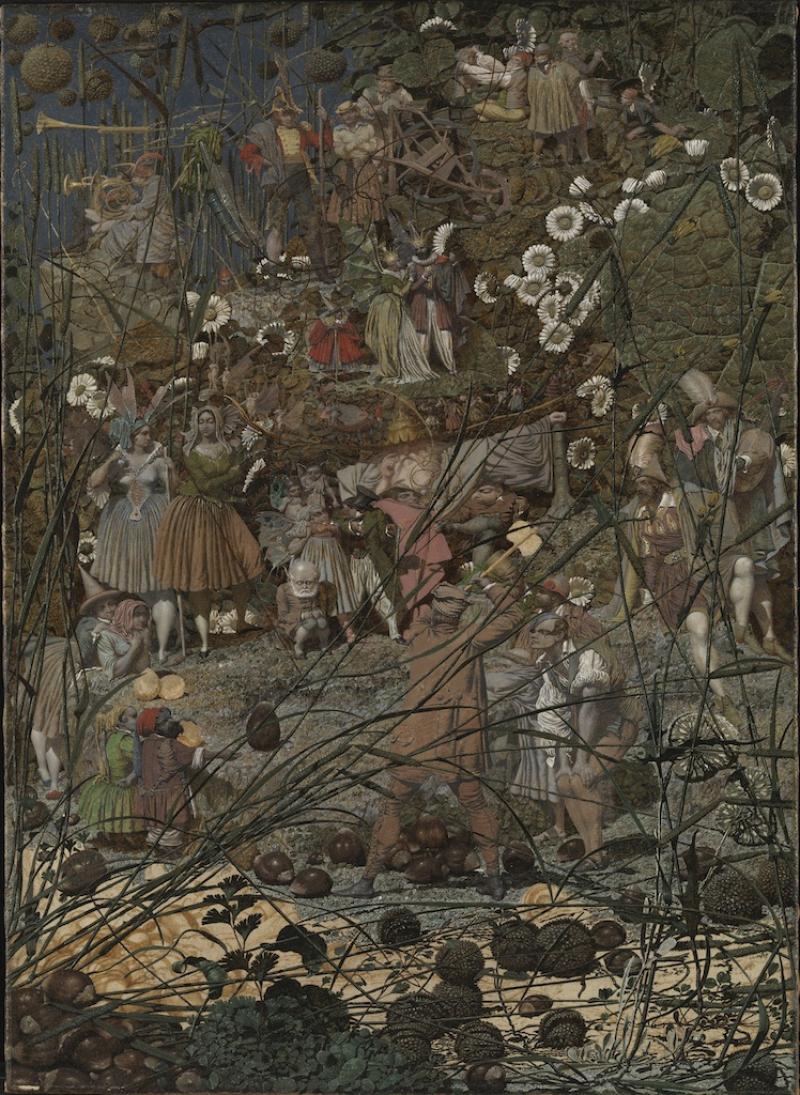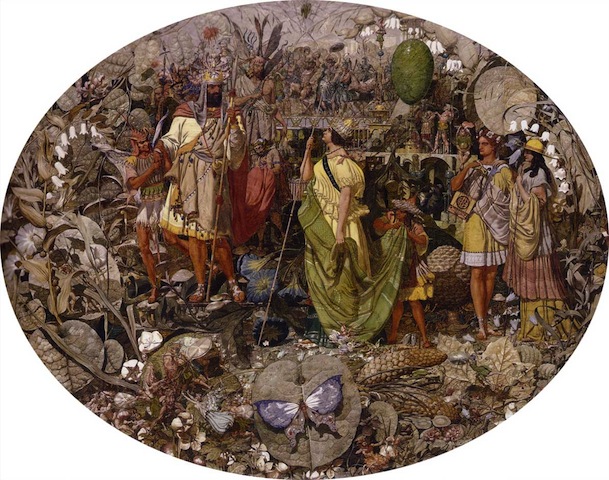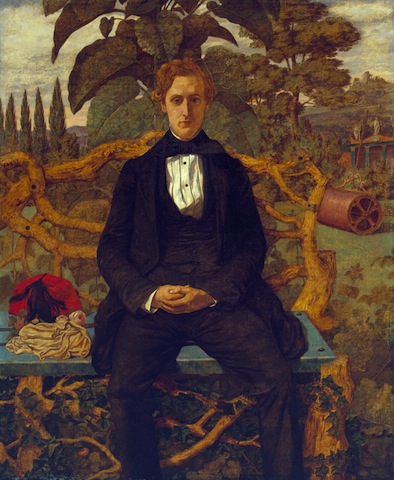Richard Dadd: The Art of Bedlam, Watts Gallery | reviews, news & interviews
Richard Dadd: The Art of Bedlam, Watts Gallery
Richard Dadd: The Art of Bedlam, Watts Gallery
The Victorian artist who created an unforgettable world of fairies

The Watts Gallery in rural Surrey is a very genteel setting for a show by a figure who for most of his life was denied polite society. Richard Dadd spent 42 years in mental hospitals, first at Bethlem, then Broadmoor. As one can infer, he was criminally insane, and despite a disarming interest in fairies, his life and work cannot be spun into a happy-ever-after narrative.
It's the fairies not the diagnosis that won him acclaim, inspiring his two greatest works: The Fairy Feller’s Master-Stroke, 1855-64 (main picture) and Contradiction. Oberon and Titania,1854-58 (pictured below) are both in this exhibition and offer mythical scenes which conflate Shakespeare with the creative universe of Dadd himself. The artist wrote his own 24-page poem to accompany the first; the second owes its drama to A Midsummer’s Night Dream.
As you can imagine, we are here a long way from Disney’s Tinker Bell. Dadd’s cast emerge from the undergrowth in multitudes: troll-like, satyr-like, centaur-like, but more often than not in perfect, if tiny, human form. Most of their faces are wan grey, as if in imitation of early photographs. And the viewer has to peer through blades of grass and past dock leaves to take in the processional action; the artist is such a fine miniaturist that to-scale daisies and snowdrops have larger heads than his figures.
 The fairy feller’s “master-stroke” had its catastrophic real-world counterpart; in the grip of psychosis in 1843, Dadd felled his father with a knife. Then in one of the most upsetting artist quotes ever, he cried to the star-filled heavens: “Go and tell the great god Osiris that I have done the deed which is to set him free”. (Osiris showed his new servant few favours, because after trying to kill a fellow coach passenger, Dadd was arrested in France.)
The fairy feller’s “master-stroke” had its catastrophic real-world counterpart; in the grip of psychosis in 1843, Dadd felled his father with a knife. Then in one of the most upsetting artist quotes ever, he cried to the star-filled heavens: “Go and tell the great god Osiris that I have done the deed which is to set him free”. (Osiris showed his new servant few favours, because after trying to kill a fellow coach passenger, Dadd was arrested in France.)
Biographical readings may at times be lazy criticism. But the alternative, to write up this show with no reference to the artist’s crime, state of mind or studio arrangements, would require suspension of reality to an equally mad degree. In room one is the ledger from Bethlem, larger than most of his paintings, in which we can read Dadd’s name and occupation for ourselves. There is also a photo of the artist at work on Contradiction; his pale eyes look dangerous. His case notes are reproduced on the wall and mention a portfolio of portraits in which all his friends appear with their throats cut.
So it is very difficult to evaluate Dadd without the medical tourism. His work “haunts”; it “disturbs”; it is “possessed”. Nineteenth-century madness appears wilder and more frightening than its 21st century equivalent, with our care in the community and our second generation drugs. Had the artist recovered, this might have become a tragedy we could nicely assimilate. But as it is, his life and work remain totally uncanny.
But Dadd himself might have been happy. He encountered humane doctors. And a 20-year spell in Broadmoor offered him picturesque surroundings, plenty to read, and the company of educated fellow patients. His art was encouraged and, thanks to hospital sponsorship, he was never short of the best materials. Painting was an inalienable talent and it ran deeper than his mental afflictions.
 Indeed, he appears to suspend those altogether in order to paint Portrait of a Young Man in 1853 (pictured right; Tate). This shows his doctor, and collector, William Charles Hood, exhibiting calm, poise and good humour – all those qualities that psychotic, nervous or depressive illness can put beyond reach. The only concession to madness here is the fantastical setting: a pleasure garden with a ruined folly in the distance.
Indeed, he appears to suspend those altogether in order to paint Portrait of a Young Man in 1853 (pictured right; Tate). This shows his doctor, and collector, William Charles Hood, exhibiting calm, poise and good humour – all those qualities that psychotic, nervous or depressive illness can put beyond reach. The only concession to madness here is the fantastical setting: a pleasure garden with a ruined folly in the distance.
It was Hood who suggested that Dadd make his 32 watercolour Sketches to Illustrate the Passions. Raving Madness takes the form of an exophthalmic figure in chains. Self-contempt features a short artist, who touts a portfolio, in a suit much too big for him. Hatred depicts a murder and the ecstatic murderer wears Tudor finery. In this series, as elsewhere, the artist never gives you quite what you might expect. Inevitably the Passions series tells you that the human condition is idiosyncratic.
Dadd may be a patricide, but he comes across as an individual. He is not an archetype, like Oedipus, but a real person responsible for an irreversible act of passion. Unlike many of those who get called outsider artists, he was established in the art world before his first breakdown. Given a clean bill of health, he might have enjoyed a career as illustrious and respectable as George Frederick Watts, in whose dedicated gallery he now enjoys this sharp, traumatic show.
It matters little that, as we are told, poet Siegfried Sassoon and singer Freddie Mercury were among Dadd’s admirers. And whatever various hippies saw in his mystical, pastoral vision is blighted by the horror of his biography. Thanks to his ongoing violent conduct, he is no advertisement for the rights of psychiatric patients. And yet his illness, which came on during a visit to the Middle East, could have happened to anyone. That is an uncomfortable truth which the fairies tend to obscure.
In this respect, The Artist’s Halt in the Desert, c.1845, offers us a full stop rather than a temporary layover. This romantic painting shows a group of adventurous Victorians around a campfire, beneath a full moon and circled by the ghostly rocks of a distant mountain range. Two years after his committal, the artist depicts a world to which he would never return. We cannot know how he felt about this, but we can say that the picture is pregnant with mystery. Like a fit of insanity, it is out of this world.
Share this article
The future of Arts Journalism
You can stop theartsdesk.com closing!
We urgently need financing to survive. Our fundraising drive has thus far raised £49,000 but we need to reach £100,000 or we will be forced to close. Please contribute here: https://gofund.me/c3f6033d
And if you can forward this information to anyone who might assist, we’d be grateful.

Subscribe to theartsdesk.com
Thank you for continuing to read our work on theartsdesk.com. For unlimited access to every article in its entirety, including our archive of more than 15,000 pieces, we're asking for £5 per month or £40 per year. We feel it's a very good deal, and hope you do too.
To take a subscription now simply click here.
And if you're looking for that extra gift for a friend or family member, why not treat them to a theartsdesk.com gift subscription?
more Visual arts
 'We are bowled over!' Thank you for your messages of love and support
Much-appreciated words of commendation from readers and the cultural community
'We are bowled over!' Thank you for your messages of love and support
Much-appreciated words of commendation from readers and the cultural community
 Folkestone Triennial 2025 - landscape, seascape, art lovers' escape
Locally rooted festival brings home many but not all global concerns
Folkestone Triennial 2025 - landscape, seascape, art lovers' escape
Locally rooted festival brings home many but not all global concerns
 Sir Brian Clarke (1953-2025) - a personal tribute
Remembering an artist with a gift for the transcendent
Sir Brian Clarke (1953-2025) - a personal tribute
Remembering an artist with a gift for the transcendent
 Emily Kam Kngwarray, Tate Modern review - glimpses of another world
Pictures that are an affirmation of belonging
Emily Kam Kngwarray, Tate Modern review - glimpses of another world
Pictures that are an affirmation of belonging
 Kiefer / Van Gogh, Royal Academy review - a pairing of opposites
Small scale intensity meets large scale melodrama
Kiefer / Van Gogh, Royal Academy review - a pairing of opposites
Small scale intensity meets large scale melodrama
 Jenny Saville: The Anatomy of Painting, National Portrait Gallery review - a protégé losing her way
A brilliant painter in search of a worthwhile subject
Jenny Saville: The Anatomy of Painting, National Portrait Gallery review - a protégé losing her way
A brilliant painter in search of a worthwhile subject
 Abstract Erotic, Courtauld Gallery review - sculpture that is sensuous, funny and subversive
Testing the boundaries of good taste, and winning
Abstract Erotic, Courtauld Gallery review - sculpture that is sensuous, funny and subversive
Testing the boundaries of good taste, and winning
 Edward Burra, Tate Britain review - watercolour made mainstream
Social satire with a nasty bite
Edward Burra, Tate Britain review - watercolour made mainstream
Social satire with a nasty bite
 Ithell Colquhoun, Tate Britain review - revelations of a weird and wonderful world
Emanations from the unconscious
Ithell Colquhoun, Tate Britain review - revelations of a weird and wonderful world
Emanations from the unconscious
 Rachel Jones: Gated Canyons, Dulwich Picture Gallery review - teeth with a real bite
Mouths have never looked so good
Rachel Jones: Gated Canyons, Dulwich Picture Gallery review - teeth with a real bite
Mouths have never looked so good
 Yoshitomo Nara, Hayward Gallery review - sickeningly cute kids
How to make millions out of kitsch
Yoshitomo Nara, Hayward Gallery review - sickeningly cute kids
How to make millions out of kitsch
 Hamad Butt: Apprehensions, Whitechapel Gallery review - cool, calm and potentially lethal
The YBA who didn’t have time to become a household name
Hamad Butt: Apprehensions, Whitechapel Gallery review - cool, calm and potentially lethal
The YBA who didn’t have time to become a household name

Add comment